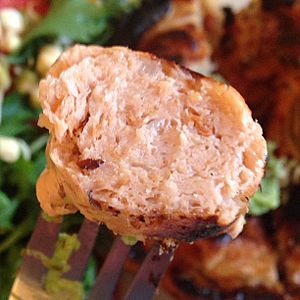Mycoprotein facts for kids

Mycoprotein is a type of protein made from fungi. Think of it like a special kind of protein that comes from mushrooms or molds. It's also known as "fungal protein." People eat it as a healthy food, often as a meat substitute.
Contents
How Mycoprotein Was Discovered
The most famous mycoprotein you might know is called Quorn. It's made from a specific fungus named Fusarium venenatum.
In the 1960s, a British company called Rank Hovis McDougall was looking for new protein sources. They studied over 3,000 types of fungi. They wanted to find one that was easy to grow, healthy, and tasted good.
Fusarium venenatum was chosen as the best option. However, scientists needed to be sure it was safe to eat. They spent 12 years testing it very carefully. It became one of the most tested food products in England before it was allowed to be sold. Today, Fusarium venenatum is the only fungus approved to make mycoprotein for sale in many places.
How Mycoprotein Is Made
Making mycoprotein is a bit like brewing. The fungus is grown in large containers called vats.
First, the vat is filled with a special liquid food, like a sugar syrup. Then, tiny fungal spores are added. The fungus needs oxygen to grow, so air is pumped into the vat. Carbon dioxide, which the fungus produces, is removed.
To help the fungus grow into protein, nitrogen (from ammonia) is added. Vitamins and minerals are also included. The vat is kept at a steady, warm temperature. This helps the fungus grow very fast. It can even double its size every five hours!
Once enough mycoprotein has grown, the liquid is drained. The mycoprotein is then separated and cleaned. It looks like a pale yellow solid and has a mild mushroom taste. Different flavors can be added to it later to make various foods.
Health Benefits of Mycoprotein
Mycoprotein is a very healthy food choice. It is rich in protein but very low in fat. This makes it a good option for people who want to eat less fat but still get enough protein.
Eating mycoprotein can also help you feel full for longer. This means you might eat less overall. For example, replacing two servings of meat with mycoprotein could help reduce your daily calorie intake.
The fungus Fusarium venenatum also has a lot of fiber. Fiber is great for your digestion and can help manage blood sugar levels. Scientists are still learning exactly how it works. But they know it can slow down how quickly your body absorbs sugar. This helps keep your blood sugar levels more stable.
Mycoprotein is not just a good source of protein and fiber. It can also act as a prebiotic. This means it helps the good bacteria in your gut grow, which is important for a healthy digestive system.
See also
 In Spanish: Micoproteína para niños
In Spanish: Micoproteína para niños

